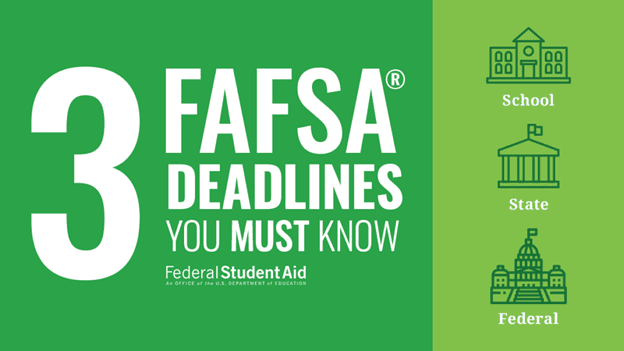
Ah, deadlines: sworn enemy of students across the nation. When you’re busy with classes, extracurricular activities, and a social life, it’s easy to let due dates whoosh by. Exam, term paper, Spanish club meeting…We get it.
Nevertheless, we’re here to point out a few more critical commitments to add to your calendar: Free Application for Federal Student Aid (FAFSA®) deadlines. It’s essential that you submit your FAFSA form on time, or you might lose out on big money that can help you pay for college.
The College Deadline
The first type of due date comes from colleges themselves, and—spoiler alert—it’s typically early. College deadlines vary from school to school, but usually come well before the academic year starts. If you’re applying to multiple colleges, look up each school’s FAFSA deadline and apply by the earliest one.
Many college FAFSA due dates are priority deadlines. This means that you need to get your FAFSA form in by that date to be considered for the most money. Many colleges have this date clearly marked on their financial aid webpages. If you can’t find it, you can always call the school’s financial aid office.
If you’re worried about gathering information to complete the FAFSA form in time to meet this deadline, don’t be. You can apply beginning Oct. 1. You’ll use 2018 tax information, so there’s no need for estimates.
Didn’t think it could get any easier? The Oct. 1 launch date coincides with many college application deadlines, so we recommend submitting admission and federal aid applications at the same time. If you haven’t figured out where you’re applying yet, don’t worry! You can still submit the FAFSA form. Just list any school you’re considering, even if you’re not sure whether you’ll apply or be accepted. You can always add or remove schools to your FAFSA form later.
2. The State Deadline
The second deadline is set by your home state. You can check your state’s deadline. Some states have hard deadlines and others have suggested dates to make sure you get priority consideration for college money. Many states have limited funds, so their FAFSA deadlines may be quite early. If your state’s deadline is “as soon as possible after Oct. 1, 2019,” you should get your FAFSA form submitted ASAP. Many of these states have limited funds and offer financial aid only until they run out, so the sooner you apply, the better your chances.
3. The Federal Deadline
This last deadline comes from us, the U.S. Department of Education, aka the FAFSA folks. Our only time constraint is that each year’s FAFSA form is no longer available after June 30 for that particular academic year.
That means that the 2020–21 FAFSA form will disappear from fafsa.gov on June 30, 2021, because that’s the end of the 2020–21 school year. That’s right—you can technically go through your entire year at college before accessing the FAFSA form. However, a few federal student aid programs have limited funds, so be sure to apply as soon as you can. Also, as we said, earlier deadlines from states and colleges make waiting a bad idea.
Why so many due dates?
Each of these entities awards financial aid differently and at different times. What they all have in common, though, is that they use the FAFSA form to see whether you’re eligible for their aid programs. So when a college wants to offer its aid before the academic year starts, it needs your FAFSA form to do so. If you want in on that money to help you pay for college, you need to meet the deadline. The same goes for state aid programs. Additionally, many outside scholarship programs need to see your FAFSA info before they will consider your application. If you’re applying for scholarships, you need to stay on top of those deadlines, too.
What happens if I miss the deadlines?
Don’t miss the deadlines. Plan to get your FAFSA form in by the earliest of all the due dates for your best crack at college money. By missing deadlines, you take yourself out of the running for money you might otherwise get. Some states and colleges continue to award aid to FAFSA latecomers, but your chances get much slimmer, and the payout is often lower.
If you miss the end-of-June federal deadline, you’re no longer eligible to submit that year’s FAFSA form. Did we mention you shouldn’t miss the deadlines?
As the saying goes, “the sooner the better.” So turn in your FAFSA form (and that term paper!) as soon as possible.

 (630) 841-3193
(630) 841-3193